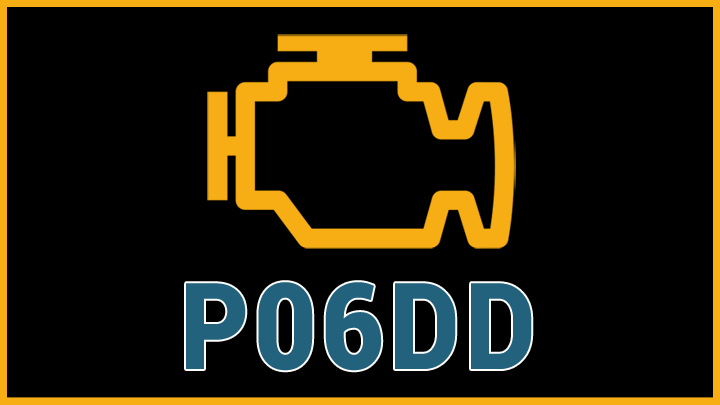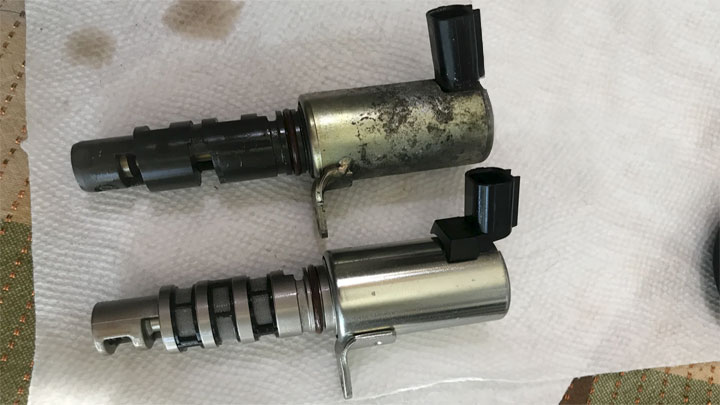P06dd Code (Symptoms, Causes, and How to Fix)
You’ve just learned that your check engine light that has been traced back to an active P06DD fault code. Now what?
Well for starters, take this code seriously. Because it indicates a problem with oil pressure, engine damage may be the result if you simply ignore it.
In this article, we’ll look at the the causes and symptoms of a P06DD code as well as how to properly troubleshoot and fix the issue.

What Does Code P06DD Mean?
Diagnostic trouble code (DTC) P06DD is indicative of a discrepancy between anticipated and actual engine oil pressure, at various engine speeds.
This code, itself, is largely manufacturer-specific and is most common among Dodge and Ford vehicles. The presence of this fault also denotes a potential oil control valve failure.
Further expanding upon the statement above, many modern engines now come equipped with oil pressure control valves, which allow for oil circuit pressure relief under certain circumstances and conditions. A valve of this type features an orifice that varies in diameter based on PCM demands, causing oil pressure to rise or lower as commanded.
Diagnostic fault code P06DD is logged, whenever such pressure variations are not measured as anticipated.
Fault code P06DD will remain active for as long as such measurable discrepancies in oil pressure remain. In the meantime, inadequate oil pressure within an engine can lead to significant damage to internal components, thus negatively impacting engine longevity.
Because of that, prompt diagnosis of the issue is of great importance when dealing with an active P06DD fault.
Related Oil Pressure Codes: P0520, P0521, P0522, P0523
Symptoms of Code P06DD

DTC P06DD is often associated with a variety of secondary symptoms, ranging from subtle to highly noticeable. Individuals who can identify these symptoms typically have a much better chance of an accurate diagnosis.
Below are several of the most common symptoms linked to code P06DD.
- Check engine light is on
- Reduced engine performance
- Erratic idle
- Noticeable vibration
- Intermittent stalling
Causes of Code P06DD

Diagnostic fault code P06DD can be caused by one of several different underlying issues, some of which can prove slightly difficult to pinpoint at times. Understanding the most likely causes for this fault code will help you in your efforts of fixing the issue.
- Low engine oil
- Contaminated engine oil
- Faulty oil pressure sensor
- Bad oil pressure control valve
- Damaged circuit-specific harness
- Compromised oil pump
Is Code P06DD Serious?
Yes, DTC P06DD is generally regarded as being serious in nature. This is due in large part to ramifications that are often associated with low engine oil pressure.
Relative loss of engine oil pressure can quickly damage internal engine components, up to the point of causing catastrophic engine failure. Simply put, diagnostic fault code P06DD should always be taken seriously.
Proper engine oil pressure is essential to the long-term health of moving or reciprocating internal engine components. Without this lubrication, metal-on-metal friction will quickly lead to the degradation of critical wear items, such as main/connecting rod bearings, and piston rings. Once such wear begins, it continues indefinitely.
In any event, the root cause of a vehicle’s P06DD fault code should be thoroughly diagnosed and repaired at your earlies convenience. Doing so can quite possibly prevent premature engine wear and failure.
If you’re not confident in your ability to perform these repairs on your own, make an appointment with a trusted automotive service center as soon as possible.
How to Fix Code P06DD

The following steps can be used to assist in diagnosing and repairing the root cause of your vehicle’s P06DD diagnostic fault code. As always, one should consult factory-specific service literature for their particular model of vehicle before attempting any such repairs.
To help diagnose and fix the underlying issue triggering your vehicle’s P06DD code, follow the steps outlined below. However, before attempting any repairs, refer to the factory-specific service manual for your particular vehicle model to confirm you have the correct information and procedures.
#1 – Check for Additional DTCs
Before beginning any diagnostic process, check for the presence of any additional diagnostic fault codes. Any such faults that are recorded should be thoroughly diagnosed before proceeding.
Multiple codes may help with diagnosis if they’re related but unrelated trouble codes can easily lead to misdiagnosis or ineffective repairs.
#2 – Inspect for Oil Leaks
Begin the diagnostic process by inspecting for signs of significant oil leakage. This can be easily done by parking the affected vehicle over a clean piece of cardboard overnight.
The cardboard in question can be checked for signs of oil contamination. You should also check the vehicle’s oil filter, especially if an oil change has recently been conducted.
#3 – Check Oil Level/Quality
Next, check the affected vehicle’s oil level, to see if it falls outside of the specified acceptable range. If this level is low, or if it has been an extremely long time since the vehicle’s oil has been changed, a full oil/filter change is recommended.
#4 – Test Oil Pressure Mechanically
If diagnostic fault code P06DD still persists, your engine’s oil pressure should be checked with the use of a mechanical gauge. The gauge in question should be plumbed into the same orifice where the vehicle’s stock oil pressure gauge resides.
Oil pressure readings should be compared to that specified by a vehicle’s manufacturer, at various engine speeds. If an actual reduction in oil pressure is noted, testing of the engine’s oil pressure control valve should be conducted, per manufacturer recommendations.
#5 – Inspect Oil Pressure Sensor
If the above testing revealed no loss in oil pressure, the affected vehicle’s oil pressure sensor should be thoroughly inspected for signs of damage, as should the wiring pigtail related to this sensor. Any damage uncovered should be repaired immediately.
Aside from this, readings from this sensor should be compared to those taken with the aforementioned mechanical gauge. If discrepancies are noted, testing of the vehicle’s oil pressure sensor should be conducted per factory recommendations.
If such testing fails, the vehicle’s oil pressure sensor will require replacement.
- 4 Causes of Smoke Coming Out of Your Car Vents - Jun 20, 2024
- 6 Reasons Why Your Car Won’t Start After Getting Gas - Jun 17, 2024
- P2196 Code (Symptoms, Causes, and How to Fix) - Jun 13, 2024

can a car be inspected with a po6dd code
I don’t see why not. It’ll take some diagnostic work to figure out the root cause anyway.